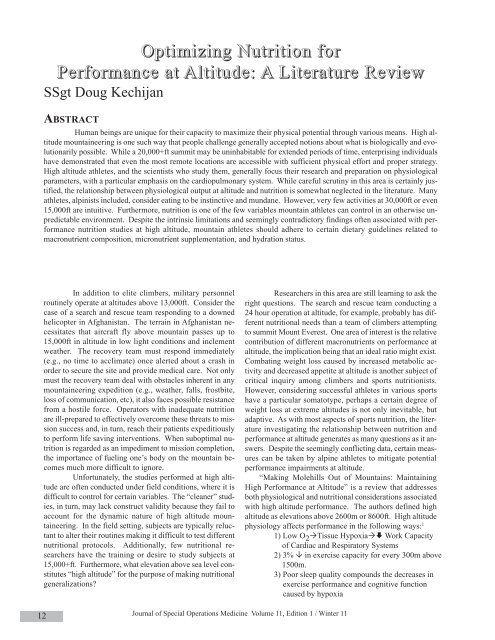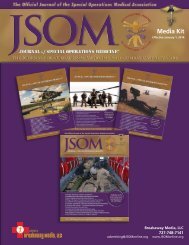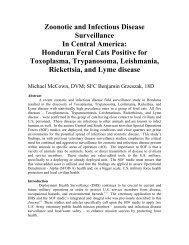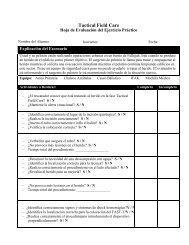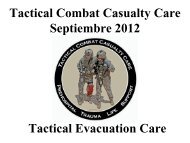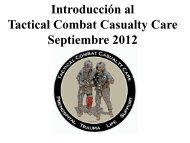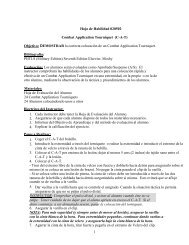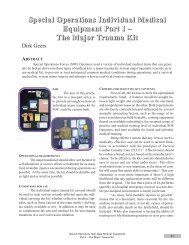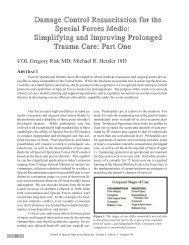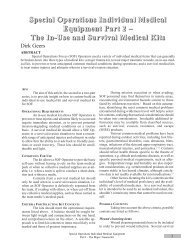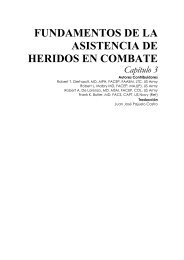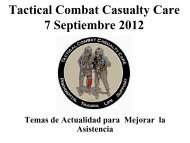Kechijan D. Optimizing Nutrition for Performance at Altitude
Kechijan D. Optimizing Nutrition for Performance at Altitude
Kechijan D. Optimizing Nutrition for Performance at Altitude
Create successful ePaper yourself
Turn your PDF publications into a flip-book with our unique Google optimized e-Paper software.
<strong>Optimizing</strong> <strong>Nutrition</strong> <strong>for</strong><br />
Per<strong>for</strong>mance <strong>at</strong> <strong>Altitude</strong>: A Liter<strong>at</strong>ure Review<br />
SSgt Doug <strong>Kechijan</strong><br />
ABSTRACT<br />
Human beings are unique <strong>for</strong> their capacity to maximize their physical potential through various means. High altitude<br />
mountaineering is one such way th<strong>at</strong> people challenge generally accepted notions about wh<strong>at</strong> is biologically and evolutionarily<br />
possible. While a 20,000+ft summit may be uninhabitable <strong>for</strong> extended periods of time, enterprising individuals<br />
have demonstr<strong>at</strong>ed th<strong>at</strong> even the most remote loc<strong>at</strong>ions are accessible with sufficient physical ef<strong>for</strong>t and proper str<strong>at</strong>egy.<br />
High altitude <strong>at</strong>hletes, and the scientists who study them, generally focus their research and prepar<strong>at</strong>ion on physiological<br />
parameters, with a particular emphasis on the cardiopulmonary system. While careful scrutiny in this area is certainly justified,<br />
the rel<strong>at</strong>ionship between physiological output <strong>at</strong> altitude and nutrition is somewh<strong>at</strong> neglected in the liter<strong>at</strong>ure. Many<br />
<strong>at</strong>hletes, alpinists included, consider e<strong>at</strong>ing to be instinctive and mundane. However, very few activities <strong>at</strong> 30,000ft or even<br />
15,000ft are intuitive. Furthermore, nutrition is one of the few variables mountain <strong>at</strong>hletes can control in an otherwise unpredictable<br />
environment. Despite the intrinsic limit<strong>at</strong>ions and seemingly contradictory findings often associ<strong>at</strong>ed with per<strong>for</strong>mance<br />
nutrition studies <strong>at</strong> high altitude, mountain <strong>at</strong>hletes should adhere to certain dietary guidelines rel<strong>at</strong>ed to<br />
macronutrient composition, micronutrient supplement<strong>at</strong>ion, and hydr<strong>at</strong>ion st<strong>at</strong>us.<br />
In addition to elite climbers, military personnel<br />
routinely oper<strong>at</strong>e <strong>at</strong> altitudes above 13,000ft. Consider the<br />
case of a search and rescue team responding to a downed<br />
helicopter in Afghanistan. The terrain in Afghanistan necessit<strong>at</strong>es<br />
th<strong>at</strong> aircraft fly above mountain passes up to<br />
15,000ft in altitude in low light conditions and inclement<br />
we<strong>at</strong>her. The recovery team must respond immedi<strong>at</strong>ely<br />
(e.g., no time to acclim<strong>at</strong>e) once alerted about a crash in<br />
order to secure the site and provide medical care. Not only<br />
must the recovery team deal with obstacles inherent in any<br />
mountaineering expedition (e.g., we<strong>at</strong>her, falls, frostbite,<br />
loss of communic<strong>at</strong>ion, etc), it also faces possible resistance<br />
from a hostile <strong>for</strong>ce. Oper<strong>at</strong>ors with inadequ<strong>at</strong>e nutrition<br />
are ill-prepared to effectively overcome these thre<strong>at</strong>s to mission<br />
success and, in turn, reach their p<strong>at</strong>ients expeditiously<br />
to per<strong>for</strong>m life saving interventions. When suboptimal nutrition<br />
is regarded as an impediment to mission completion,<br />
the importance of fueling one’s body on the mountain becomes<br />
much more difficult to ignore.<br />
Un<strong>for</strong>tun<strong>at</strong>ely, the studies per<strong>for</strong>med <strong>at</strong> high altitude<br />
are often conducted under field conditions, where it is<br />
difficult to control <strong>for</strong> certain variables. The “cleaner” studies,<br />
in turn, may lack construct validity because they fail to<br />
account <strong>for</strong> the dynamic n<strong>at</strong>ure of high altitude mountaineering.<br />
In the field setting, subjects are typically reluctant<br />
to alter their routines making it difficult to test different<br />
nutritional protocols. Additionally, few nutritional researchers<br />
have the training or desire to study subjects <strong>at</strong><br />
15,000+ft. Furthermore, wh<strong>at</strong> elev<strong>at</strong>ion above sea level constitutes<br />
“high altitude” <strong>for</strong> the purpose of making nutritional<br />
generaliz<strong>at</strong>ions?<br />
Researchers in this area are still learning to ask the<br />
right questions. The search and rescue team conducting a<br />
24 hour oper<strong>at</strong>ion <strong>at</strong> altitude, <strong>for</strong> example, probably has different<br />
nutritional needs than a team of climbers <strong>at</strong>tempting<br />
to summit Mount Everest. One area of interest is the rel<strong>at</strong>ive<br />
contribution of different macronutrients on per<strong>for</strong>mance <strong>at</strong><br />
altitude, the implic<strong>at</strong>ion being th<strong>at</strong> an ideal r<strong>at</strong>io might exist.<br />
Comb<strong>at</strong>ing weight loss caused by increased metabolic activity<br />
and decreased appetite <strong>at</strong> altitude is another subject of<br />
critical inquiry among climbers and sports nutritionists.<br />
However, considering successful <strong>at</strong>hletes in various sports<br />
have a particular som<strong>at</strong>otype, perhaps a certain degree of<br />
weight loss <strong>at</strong> extreme altitudes is not only inevitable, but<br />
adaptive. As with most aspects of sports nutrition, the liter<strong>at</strong>ure<br />
investig<strong>at</strong>ing the rel<strong>at</strong>ionship between nutrition and<br />
per<strong>for</strong>mance <strong>at</strong> altitude gener<strong>at</strong>es as many questions as it answers.<br />
Despite the seemingly conflicting d<strong>at</strong>a, certain measures<br />
can be taken by alpine <strong>at</strong>hletes to mitig<strong>at</strong>e potential<br />
per<strong>for</strong>mance impairments <strong>at</strong> altitude.<br />
“Making Molehills Out of Mountains: Maintaining<br />
High Per<strong>for</strong>mance <strong>at</strong> <strong>Altitude</strong>” is a review th<strong>at</strong> addresses<br />
both physiological and nutritional consider<strong>at</strong>ions associ<strong>at</strong>ed<br />
with high altitude per<strong>for</strong>mance. The authors defined high<br />
altitude as elev<strong>at</strong>ions above 2600m or 8600ft. High altitude<br />
physiology affects per<strong>for</strong>mance in the following ways: 1<br />
1) Low O 2 Tissue Hypoxia Work Capacity<br />
of Cardiac and Respir<strong>at</strong>ory Systems<br />
2) 3% in exercise capacity <strong>for</strong> every 300m above<br />
1500m.<br />
3) Poor sleep quality compounds the decreases in<br />
exercise per<strong>for</strong>mance and cognitive function<br />
caused by hypoxia<br />
12<br />
Journal of Special Oper<strong>at</strong>ions Medicine Volume 11, Edition 1 / Winter 11
The nutritional recommend<strong>at</strong>ions the authors advoc<strong>at</strong>e<br />
to maximize per<strong>for</strong>mance <strong>at</strong> altitude focus on hydr<strong>at</strong>ion,<br />
nutritional quantity, and nutritional composition. Fluid<br />
loss <strong>at</strong> altitude is <strong>at</strong>tributed to increased swe<strong>at</strong>ing from exertion,<br />
ventil<strong>at</strong>ion changes occurring in cold, dry air, and<br />
cold we<strong>at</strong>her diuresis. The l<strong>at</strong>ter condition is characterized<br />
by the increased urine output associ<strong>at</strong>ed with shunting of<br />
blood to the core and the deceivingly high pressure readings<br />
in the baroreceptors as the body <strong>at</strong>tempts to maintain normothermia.<br />
Based on available research, the authors recommend<br />
th<strong>at</strong> <strong>at</strong>hletes working <strong>at</strong> altitude consume 3-5L of<br />
fluid per day to replace losses from respir<strong>at</strong>ion, urine, swe<strong>at</strong>,<br />
and he<strong>at</strong> regul<strong>at</strong>ion. 1 The authors caution th<strong>at</strong> consuming<br />
too much w<strong>at</strong>er may be counterproductive because it disrupts<br />
the decrease in plasma volume and increase in hemoconcentr<strong>at</strong>ion<br />
th<strong>at</strong> may be a positive adapt<strong>at</strong>ion upon one’s<br />
initial exposure to altitude. However, this concern seems<br />
more theoretical than practical since most <strong>at</strong>hletes tend to<br />
underconsume fluid on the mountain, especially when they<br />
must melt snow to hydr<strong>at</strong>e themselves.<br />
With regard to nutritional quantity, Freidlander et<br />
al., emphasize the importance of adequ<strong>at</strong>e caloric intake <strong>at</strong><br />
altitude. Weight loss <strong>at</strong> altitude, a common phenomenon, is<br />
triggered by increased basal metabolic r<strong>at</strong>e (BMR), increased<br />
exertion, appetite suppression associ<strong>at</strong>ed with hypoxia,<br />
and limited food availability. 1 While caloric deficit<br />
does not seem to affect per<strong>for</strong>mance in the short term, it may<br />
neg<strong>at</strong>ively impact work capacity in expeditions lasting<br />
weeks or months. Additionally, appetite may not reflect nutritional<br />
needs <strong>at</strong> altitude. Since the rel<strong>at</strong>ive contribution of<br />
carbohydr<strong>at</strong>es as a fuel source may increase <strong>at</strong> altitude, adequ<strong>at</strong>e<br />
carbohydr<strong>at</strong>e intake is emphasized by the authors. In<br />
the short term (three weeks or less), caloric deficit may not<br />
impair per<strong>for</strong>mance as long as glycogen stores are maintained.<br />
1 Consequently, the authors recommend th<strong>at</strong> 60% or<br />
more of a mountain <strong>at</strong>hlete’s caloric intake come from carbohydr<strong>at</strong>es<br />
as a means of ensuring adequ<strong>at</strong>e glycogen storage.<br />
While research on the effect of f<strong>at</strong> intake <strong>at</strong> altitude is<br />
limited, the authors regard high f<strong>at</strong> foods as valuable to<br />
alpine <strong>at</strong>hletes because they tend to be calorically dense and<br />
easy to transport in the field. While Freidlander’s guidelines<br />
<strong>for</strong> high altitude nutrition are generally conserv<strong>at</strong>ive and uncontroversial,<br />
their carbohydr<strong>at</strong>e recommend<strong>at</strong>ions are<br />
higher than wh<strong>at</strong> is supported in the liter<strong>at</strong>ure.<br />
Benso et al., assessed the metabolic and endocrine<br />
adapt<strong>at</strong>ions in nine male, well-trained, elite climbers from<br />
the 2004 Italian Mount Everest expedition team, five of<br />
whom reached the summit (8852m). The remaining four all<br />
climbed to <strong>at</strong> least 7500m. While the authors did not focus<br />
explicitly on nutritional interactions, their findings have nutritional<br />
implic<strong>at</strong>ions. The climbing team completed a progressive<br />
acclim<strong>at</strong>iz<strong>at</strong>ion program prior to arriving <strong>at</strong> Mount<br />
Everest base camp and commencing the study. The subjects<br />
completed a metabolic and hormonal evalu<strong>at</strong>ion (following<br />
an overnight fast) one month be<strong>for</strong>e the expedition and <strong>at</strong><br />
base camp upon returning from their summit <strong>at</strong>tempt. While<br />
there is no mention of absolute caloric intake, the climbers<br />
had access to pal<strong>at</strong>able foods and on average consumed a diet<br />
th<strong>at</strong> contained 58% carbohydr<strong>at</strong>e, 30% lipid, and 12% protein.<br />
The results were as follows: no Acute Mountain Sickness or<br />
edema, average weight loss of 5kg, growth hormone-insulin-like<br />
growth factor (GH/IGF-1), T 3 , no change in leptin<br />
or ghrelin despite body weight loss, prolactin and<br />
progesterone, testosterone, no change in cortisol, dependence<br />
on glucose, insulin sensitivity, and rel<strong>at</strong>ive contribution<br />
from lipid. 2 The authors specul<strong>at</strong>e th<strong>at</strong> these changes<br />
may have been caused by low tissue oxygen, dehydr<strong>at</strong>ion,<br />
and/or nutritional interactions. Since exercise is known to enhance<br />
GH response to GH-releasing factor, it is uncertain<br />
whether the GH increases were caused by exercise, altitude, or<br />
a combin<strong>at</strong>ion of both; none of the subjects remained <strong>at</strong> base<br />
camp during the study so it is not possible to differenti<strong>at</strong>e. The<br />
authors specul<strong>at</strong>e th<strong>at</strong> the upregul<strong>at</strong>ion of the GH/IGF-1 axis<br />
may trigger protein anabolism while influencing changes in<br />
carbohydr<strong>at</strong>e and lipid metabolism.<br />
They also specul<strong>at</strong>e th<strong>at</strong> prolactin may affect glucose<br />
metabolism. 2 Furthermore, they suggest the increase in prolactin<br />
may reflect stress induced changes in testosterone production.<br />
This suggestion is contradicted, they concede, by the<br />
lack of change in cortisol or adrenocorticotropic hormone<br />
(ACTH). The mechanism by which leptin and ghrelin remained<br />
the same despite the significant decrease in body<br />
weight requires further study. The results do, however, support<br />
the notion th<strong>at</strong> s<strong>at</strong>iety signals th<strong>at</strong> suffice <strong>at</strong> sea level may<br />
be altered <strong>at</strong> high altitude, which reaffirms the notion th<strong>at</strong><br />
mountain <strong>at</strong>hletes should not rely on hunger as an indic<strong>at</strong>or of<br />
nutritional st<strong>at</strong>us. The authors deserve praise <strong>for</strong> collecting<br />
d<strong>at</strong>a under such severe conditions on world class <strong>at</strong>hletes.<br />
Their findings help gener<strong>at</strong>e the following questions <strong>for</strong> future<br />
research:<br />
1) Would the metabolic and hormonal profiles of<br />
these <strong>at</strong>hletes vary if caloric intake was controlled<br />
(e.g., less of an energy deficit)?<br />
2) Do these metabolic changes occur <strong>at</strong> lesser (albeit<br />
still “high”) altitudes or are they specific to the<br />
tallest mountains in the world, like Mount Everest?<br />
3) Is the increased dependence on glucose seen in<br />
these <strong>at</strong>hletes a product of the rel<strong>at</strong>ively high exercise<br />
intensity they are able to maintain <strong>at</strong> altitude?<br />
Do well-trained, but not world-class climbers exhibit<br />
different substr<strong>at</strong>e utiliz<strong>at</strong>ion while traveling<br />
<strong>at</strong> lower speeds and with less intensity?<br />
4) In light of the possible influence of prolactin and<br />
progesterone on glucose metabolism, do females<br />
and males each have different nutritional needs <strong>at</strong><br />
high altitude?<br />
In another Mount Everest study, Reynolds et al., employed<br />
a double crossover design over nine weeks to determine<br />
the effects of variable macronutrient distribution <strong>at</strong> high altitude<br />
on five women and ten men from the United St<strong>at</strong>es, Mexico,<br />
and The Netherlands. The ten most experienced climbers<br />
<strong>at</strong>tempted to summit while the other subjects never exceeded<br />
5600m in altitude and remained primarily <strong>at</strong> base camp. All of<br />
the subjects followed a strict acclim<strong>at</strong>iz<strong>at</strong>ion protocol prior to<br />
arriving <strong>at</strong> base camp. The researchers divided the subjects<br />
<strong>Optimizing</strong> <strong>Nutrition</strong> <strong>for</strong> Per<strong>for</strong>mance <strong>at</strong> <strong>Altitude</strong>: A Liter<strong>at</strong>ure Review 13
into a high f<strong>at</strong>, low carbohydr<strong>at</strong>e group (35 and 50%, respectively),<br />
A, and low f<strong>at</strong>, high carbohydr<strong>at</strong>e group (20 and<br />
65%, respectively), B. The randomized crossover design<br />
protocol was as follows:<br />
Weeks 1-3: Assigned Diet<br />
Weeks 4-6: Altern<strong>at</strong>e/Non-Assigned Diet<br />
Weeks 7-9: Original, Assigned Diet<br />
At base camp, climbers were given prepared meals<br />
based on previously st<strong>at</strong>ed food preferences. Foods were<br />
self-selected during the actual expedition due to logistical<br />
constraints not encountered <strong>at</strong> base camp. However, Diet A<br />
contained 49 items not permitted on Diet B, including tuna<br />
and sardines in oil, various cheeses, shredded coconut, margarine,<br />
and other high f<strong>at</strong> foods. All subjects kept daily food<br />
logs regardless of altitude <strong>at</strong>tained. All but one subject lost<br />
weight. The authors did not consider the degree of overall<br />
weight loss excessive considering the extreme altitude.<br />
While the mean caloric intake <strong>for</strong> the climbers was significantly<br />
gre<strong>at</strong>er than th<strong>at</strong> of the people who remained <strong>at</strong> base<br />
camp (2841 vs. 2442), there was an appreciable reduction in<br />
energy intake <strong>at</strong> progressively higher altitudes. The climbers<br />
did not alter their rel<strong>at</strong>ive macronutrient contributions as they<br />
traveled further from base camp challenging the pervasive<br />
notion in the climbing community th<strong>at</strong> carbohydr<strong>at</strong>es are the<br />
preferred fuel <strong>at</strong> higher altitudes. This idea, the authors contend,<br />
is driven more so by anecdotal stories (one of which is<br />
an anonymous study from 1938) than actual research.<br />
In fact, while the authors intended <strong>for</strong> the subjects<br />
from Groups A and B to have discrete rel<strong>at</strong>ive dietary f<strong>at</strong> intakes,<br />
there was no significant difference in mean percent f<strong>at</strong><br />
intake <strong>for</strong> either group. 3 The subjects appeared to self-select<br />
diets th<strong>at</strong> provided 28% energy from f<strong>at</strong> and there was an<br />
apparent regression towards the mean carbohydr<strong>at</strong>e and f<strong>at</strong><br />
intake. Th<strong>at</strong> the subjects’ preference <strong>for</strong> f<strong>at</strong> was higher than<br />
expected is encouraging when one considers th<strong>at</strong> f<strong>at</strong>ty foods<br />
occupy less space in a climbers pack than less calorically<br />
dense foods. Despite these trends, there was considerable<br />
vari<strong>at</strong>ion in caloric intake among the subjects regardless of<br />
altitude reached. While <strong>for</strong>mulas and algorithms <strong>for</strong> energy<br />
demands <strong>at</strong> altitude may be used as a guide, an individual<br />
approach is clearly needed.<br />
The authors acknowledge th<strong>at</strong> it is not feasible to<br />
discern the individual impact of the numerous stressors (e.g.,<br />
cold, increased exertion, thre<strong>at</strong>s to survival, separ<strong>at</strong>ion from<br />
family, etc) in a study of this n<strong>at</strong>ure. They follow th<strong>at</strong> caution,<br />
however, by criticizing more rigid studies in hypobaric<br />
chambers th<strong>at</strong> control <strong>for</strong> confounding factors: “Thus it is<br />
necessary to utilize actual mountainous conditions to discern<br />
the full impact on human per<strong>for</strong>mance”. 3 There are advantages<br />
and disadvantages to both field and labor<strong>at</strong>ory research<br />
<strong>at</strong> altitude making it especially hard to gener<strong>at</strong>e concrete recommend<strong>at</strong>ions.<br />
Due to the difficultly of finding subjects capable<br />
of “per<strong>for</strong>ming” under such arduous conditions, this<br />
study is limited by its small sample size. Another inherent<br />
limit<strong>at</strong>ion of field nutrition studies like this one is th<strong>at</strong> d<strong>at</strong>a<br />
collection is contingent on accur<strong>at</strong>e reporting from the subjects.<br />
The precision of such reporting may be compromised<br />
not only by impairments in cognitive function th<strong>at</strong> occur <strong>at</strong><br />
altitude but also by climbers’ preoccup<strong>at</strong>ion with more pressing<br />
issues (e.g., survival!).<br />
Another study by Reynolds et al., (different coauthors,<br />
1999) examined the regional changes in body composition<br />
and net energy balance <strong>at</strong> high altitude (5300-8848m).<br />
Energy expenditure was assessed with doubly labeled w<strong>at</strong>er,<br />
a method th<strong>at</strong> calcul<strong>at</strong>es carbon dioxide production and oxygen<br />
consumption from the excretion of different w<strong>at</strong>er isotopes<br />
and dietary records, respectively. 4 Three base camp<br />
personnel and seven climbers received doubly labeled w<strong>at</strong>er<br />
to determine energy expenditure on Mount Everest. The researchers<br />
were unable to control <strong>for</strong> variables like age and<br />
gender because assignment to the climbing team was dependent<br />
on previous mountaineering experience. Consequently,<br />
there was an overrepresent<strong>at</strong>ion of males in the<br />
climbing group and of females in the base camp group. Two<br />
months prior to leaving the United St<strong>at</strong>es, all subjects had<br />
their resting energy expenditure calcul<strong>at</strong>ed by indirect room<br />
calorimetry. However, energy expenditure on the mountain<br />
was determined with doubly labeled w<strong>at</strong>er, which was a<br />
methodological limit<strong>at</strong>ion, albeit one justified under the circumstances.<br />
Body composition in the field was assessed<br />
with the skinfold method and there was no direct measure of<br />
the subjects’ hydr<strong>at</strong>ion st<strong>at</strong>us. All subjects were required to<br />
keep a detailed food log throughout the nine weeks. Body<br />
weight loss, not percent muscle mass or percent f<strong>at</strong> lost, was<br />
gre<strong>at</strong>er <strong>for</strong> the climbing group. Neither group lost a significant<br />
percentage of body f<strong>at</strong> rel<strong>at</strong>ive to baseline measurements.<br />
Mean energy intake (2928 vs. 2149kCal) and percent<br />
increase in energy expenditure (298 vs. 243%) were considerably<br />
higher <strong>for</strong> the climbing group. 5<br />
The authors observed th<strong>at</strong> the expected body weight<br />
loss did not correl<strong>at</strong>e significantly with actual losses, a discrepancy<br />
they <strong>at</strong>tribute to underreporting of kCals. As previously<br />
mentioned, food log accuracy is often questionable<br />
in field research of this n<strong>at</strong>ure. Nevertheless, in light of the<br />
various metabolic and hormonal changes th<strong>at</strong> occur <strong>at</strong> altitude,<br />
a “calories in-calories burned” model seems an insufficient<br />
and overly simplistic means of predicting weight loss<br />
on Mount Everest. The authors also suggest th<strong>at</strong> rapid bodyweight<br />
loss, fluid shifts, and dehydr<strong>at</strong>ion <strong>at</strong> altitude may reduce<br />
the validity of skinfold measurement. Furthermore,<br />
skinfold measurement often fails to detect the subtle changes<br />
in body f<strong>at</strong> percentage th<strong>at</strong> may occur <strong>at</strong> altitude. Nevertheless,<br />
they conclude th<strong>at</strong> there may be a preferential loss of<br />
body f<strong>at</strong> reserves and sparing of muscle tissue <strong>at</strong> altitude. 5<br />
This issue remains controversial in high altitude nutrition<br />
studies partially due to the lack of protocol standardiz<strong>at</strong>ion.<br />
Reynolds et al., propose th<strong>at</strong> a certain amount of weight loss<br />
may be inevitable since it is so difficult to maintain adequ<strong>at</strong>e<br />
caloric intake <strong>at</strong> extreme altitudes. Consumption of high f<strong>at</strong>,<br />
calorically dense foods may, however, help minimize the degree<br />
of weight loss. 5<br />
The inability to isol<strong>at</strong>e the effects of all the variables<br />
th<strong>at</strong> may affect per<strong>for</strong>mance <strong>at</strong> altitude is a limit<strong>at</strong>ion<br />
of field nutritional research, like th<strong>at</strong> conducted on Mount<br />
14<br />
Journal of Special Oper<strong>at</strong>ions Medicine Volume 11, Edition 1 / Winter 11
Everest. Mount Everest is the absolute furthest thing from a<br />
controlled environment. It is often assumed th<strong>at</strong> hypoxia triggers<br />
the physiological changes th<strong>at</strong> occur <strong>at</strong> altitude. Rose et<br />
al. monitored six trained, young male subjects <strong>for</strong> 40 days in<br />
a hypobaric chamber to determine if hypoxia per se results in<br />
weight loss and changes in dietary preferences. The idea was<br />
to artificially replic<strong>at</strong>e an expedition on Mount Everest, with<br />
the subjects “summiting” <strong>at</strong> a simul<strong>at</strong>ed altitude of 8,848m.<br />
The subjects were provided with three meals a day; the composition<br />
of which was 60% carbohydr<strong>at</strong>e, 25% f<strong>at</strong>, and 15%<br />
protein. However, the subjects only consumed foods <strong>for</strong><br />
which they had a taste. They also had access to various exercise<br />
devices in the chamber. Energy expenditure was calcul<strong>at</strong>ed<br />
using a modified Harris Benedict <strong>for</strong>mula. At the end<br />
of the 40 days, mean caloric intake decreased 43% and mean<br />
weight loss was 8.9%. 6 Unlike the Reynolds body composition<br />
study conducted on Mount Everest, there was no preferential<br />
retention of muscle mass; lean tissue accounted <strong>for</strong><br />
67% of the weight lost. The subjects lost more weight than<br />
the researchers expected based on the energy expenditure estim<strong>at</strong>es.<br />
Predicting weight loss from <strong>for</strong>mulas and simplistic<br />
models may be difficult as was alluded to previously.<br />
Carbohydr<strong>at</strong>e intake decreased from 62.1% to<br />
53.2% by the end of the study. 6 The decrease in rel<strong>at</strong>ive carbohydr<strong>at</strong>e<br />
intake led the researchers to conclude th<strong>at</strong> the apparent<br />
carbohydr<strong>at</strong>e preference championed by many<br />
climbers is likely <strong>at</strong>tributable to the convenience and accessibility<br />
of these foods, not to a physiological phenomenon.<br />
Since temper<strong>at</strong>ure and humidity were maintained <strong>at</strong> a com<strong>for</strong>table<br />
level, it seems th<strong>at</strong> hypoxia per se was responsible<br />
<strong>for</strong> the observed weight loss. Furthermore, while the subjects<br />
were encouraged to exercise, their activity levels were<br />
not comparable to those required on an actual expedition.<br />
While weight loss may have been influenced by malabsorbtion<br />
of macronutrients <strong>at</strong> increasing altitudes, this study was<br />
not designed to explicitly test <strong>for</strong> this phenomenon. The<br />
model (hypobaric hypoxia) cre<strong>at</strong>ed by the researchers more<br />
closely simul<strong>at</strong>es the <strong>at</strong>mospheric composition <strong>at</strong> altitude<br />
than th<strong>at</strong> marketed by manufacturers of various commercially<br />
available altitude simul<strong>at</strong>ors. These devices induce hypoxia<br />
by lowering the percentage of oxygen without decreasing the<br />
overall barometric pressure. Consequently, they may not induce<br />
the same favorable adapt<strong>at</strong>ions <strong>for</strong> <strong>at</strong>hletes preparing<br />
<strong>for</strong> challenging expeditions. This study clearly exercises an<br />
appreciably gre<strong>at</strong>er degree of control over confounding variables<br />
than the research discussed previously. However, these<br />
other variables may, in fact, have nutritional implic<strong>at</strong>ions th<strong>at</strong><br />
warrant additional research using a more integr<strong>at</strong>ed approach.<br />
While most research investig<strong>at</strong>ing the rel<strong>at</strong>ionship<br />
between nutrition and per<strong>for</strong>mance <strong>at</strong> altitude focuses on<br />
macronutrient composition, some studies have focused on<br />
micronutrient interactions. The need <strong>for</strong> varying amounts of<br />
micronutrients <strong>at</strong> high altitude remains controversial, as it<br />
does in other areas of sports nutrition. It is theorized th<strong>at</strong> antioxidant<br />
requirements may increase <strong>at</strong> altitude due to increased<br />
exertion and changes in oxid<strong>at</strong>ive metabolism.<br />
Simon-Schnass, in her review “<strong>Nutrition</strong> <strong>at</strong> High <strong>Altitude</strong>”,<br />
suggests th<strong>at</strong> prophylactic vitamin E supplement<strong>at</strong>ion may<br />
comb<strong>at</strong> free radical damage associ<strong>at</strong>ed with increased oxid<strong>at</strong>ive<br />
metabolism from exertion <strong>at</strong> altitude. Since vitamin E<br />
comb<strong>at</strong>s free radical damage during various steps in the aerobic<br />
p<strong>at</strong>hway, a vitamin E deficiency, she maintains, may promote<br />
decreased cellular respir<strong>at</strong>ion and energy production;<br />
possibly contributing to the reduction in anaerobic threshold<br />
<strong>at</strong> altitude. Such neg<strong>at</strong>ive physiological changes may be compounded<br />
by low partial pressure of oxygen and decreased exercise<br />
intensities with the same perceived exertions 7 .<br />
In one vitamin E study conducted <strong>at</strong> altitude, there<br />
was no change in pentane exhal<strong>at</strong>ion with vitamin E supplement<strong>at</strong>ion<br />
compared to a > 100% increase in the control group<br />
<strong>at</strong> 5100m; pentane exhal<strong>at</strong>ion is indic<strong>at</strong>ive of vitamin E st<strong>at</strong>us<br />
and lipid perioxid<strong>at</strong>ion. 7 Assuming pentane exhal<strong>at</strong>ion does<br />
indeed reflect lipid perioxid<strong>at</strong>ion, <strong>at</strong> wh<strong>at</strong> point do increases<br />
in lipid perioxid<strong>at</strong>ion neg<strong>at</strong>ively impact per<strong>for</strong>mance or<br />
health? Simon-Schnass also proposes th<strong>at</strong> vitamin E supplement<strong>at</strong>ion<br />
protects against alter<strong>at</strong>ions in red blood cell filterability<br />
and increases in blood viscosity caused by<br />
perioxid<strong>at</strong>ion of membrane lipids. 7 Protein C, a coagul<strong>at</strong>ion<br />
inhibitor, is thought to indic<strong>at</strong>e the extent of vascular wall<br />
changes induced by oxid<strong>at</strong>ive damage. Simon-Schass suggests<br />
th<strong>at</strong> decreases in Protein C promote increased coagul<strong>at</strong>ion,<br />
which, in turn, triggers protease release (to deal with the<br />
coagul<strong>at</strong>ion) and subsequent damage to proteins in endothelial<br />
cells. This hemodynamic cascade may increase the risk of<br />
frostbite, retinal hemorrhage, and pulmonary and cerebral<br />
edema; all of which are potentially debilit<strong>at</strong>ing on the mountain.<br />
Some of the liter<strong>at</strong>ure suggests th<strong>at</strong> vitamin E supplement<strong>at</strong>ion<br />
prevents the decreases in Protein C observed <strong>at</strong><br />
altitude. Vitamin E, there<strong>for</strong>e, may stabilize endothelial cells<br />
and prevent protein degrad<strong>at</strong>ion in the vascul<strong>at</strong>ure. 7 While<br />
the results of vitamin E supplement<strong>at</strong>ion are promising, additional<br />
research th<strong>at</strong> controls <strong>for</strong> caloric intake and baseline nutritional<br />
st<strong>at</strong>us is needed to determine: 1) The point <strong>at</strong> which<br />
decreases in Protein C are p<strong>at</strong>hological <strong>at</strong> altitude and 2) How<br />
long one can continue to per<strong>for</strong>m <strong>at</strong> altitude with amplified<br />
lipid perioxid<strong>at</strong>ion be<strong>for</strong>e the changes become consequential.<br />
The liter<strong>at</strong>ure investig<strong>at</strong>ing the effects of different<br />
hydr<strong>at</strong>ion str<strong>at</strong>egies <strong>at</strong> high altitude is also quite scarce.<br />
Richardson et al. assessed the degree to which euhydr<strong>at</strong>ion,<br />
hypohydr<strong>at</strong>ion, and hyperhydr<strong>at</strong>ion during actute normobaric<br />
hypoxic conditions trigger Acute Mountain Sickness (AMS)<br />
symptoms and alter various physiological markers. The<br />
symptoms of AMS (nausea/vomiting, headache, dizziness, f<strong>at</strong>igue),<br />
while not suggestive of per<strong>for</strong>mance per se, should be<br />
avoided to optimize physiological output. 8 Increased w<strong>at</strong>er<br />
vapor loss, energy expenditure, and ventil<strong>at</strong>ion <strong>at</strong> altitude promote<br />
dehydr<strong>at</strong>ion. At sea level, dehydr<strong>at</strong>ion is associ<strong>at</strong>ed with<br />
decreased oxygen delivery, he<strong>at</strong> dissip<strong>at</strong>ion, and cognitive<br />
function. 7 Overhydr<strong>at</strong>ion, despite its positive effects on stroke<br />
volume, vasodil<strong>at</strong>ion, and he<strong>at</strong> dissip<strong>at</strong>ion <strong>at</strong> sea level, may<br />
worsen intracranial pressure and headaches <strong>at</strong> altitude via increases<br />
in extracellular volume.<br />
For this study, eight physically active males, none of<br />
whom had spent time above 2000m in the previous two<br />
<strong>Optimizing</strong> <strong>Nutrition</strong> <strong>for</strong> Per<strong>for</strong>mance <strong>at</strong> <strong>Altitude</strong>: A Liter<strong>at</strong>ure Review 15
months, completed intermittent walking tests <strong>at</strong> 50% VO 2 max<br />
after controlled euhydr<strong>at</strong>ion, hyperhydr<strong>at</strong>ion, and hypohydr<strong>at</strong>ion<br />
in a normobaric hypoxic st<strong>at</strong>e with a seven day washout<br />
period between tests. 8 Hydr<strong>at</strong>ion st<strong>at</strong>us was characterized by<br />
the degree to which subjects were permitted to replenish lost<br />
fluids following a moder<strong>at</strong>e running session conducted fifteen<br />
hours prior to the actual test. The hypo- and hyperhydr<strong>at</strong>ion<br />
st<strong>at</strong>es induced gre<strong>at</strong>er physiological strain and AMS rel<strong>at</strong>ed<br />
symptoms. 8 Although the authors were unable to identify the<br />
mechanism, the AMS symptom scores suggest th<strong>at</strong> the hypo<br />
and hyperhydr<strong>at</strong>ion st<strong>at</strong>es adversely affect feeling st<strong>at</strong>e, especially<br />
headaches, compared with euhydr<strong>at</strong>ion. 8<br />
Based on the 0.6L/h swe<strong>at</strong> r<strong>at</strong>e observed in the euhydr<strong>at</strong>ed<br />
st<strong>at</strong>e, Richardson et al., recommend th<strong>at</strong> people consume<br />
up to 5L of fluid spread throughout the day in acute<br />
hypoxic environments. Moreover, because increased physiological<br />
strain may exacerb<strong>at</strong>e AMS symptoms, a hydr<strong>at</strong>ion<br />
st<strong>at</strong>e within normal physiological limits is optimal; 7 urine<br />
color <strong>at</strong> ~2, urine specific gravity < 1.015, and urine osmolality<br />
< 400 mosm/kg should be maintained during acute hypoxic<br />
exposure. While these recommend<strong>at</strong>ions seem reasonable, the<br />
following methodological limit<strong>at</strong>ions necessit<strong>at</strong>e the need <strong>for</strong><br />
additional research in this area:<br />
1) Extremely fit individuals, like elite climbers and<br />
military Special Oper<strong>at</strong>ions Forces, may react differently<br />
to various hydr<strong>at</strong>ion st<strong>at</strong>es than did the<br />
subjects in this study, whose mean V0 2 max was<br />
43ml/kg min. Are these results also typical of<br />
people, like many alpinists, who do take the time<br />
to acclim<strong>at</strong>ize prior to exposing themselves to<br />
more extreme altitudes?<br />
2) The observed effects of different hydr<strong>at</strong>ion st<strong>at</strong>es<br />
may vary with gre<strong>at</strong>er exercise intensity and dur<strong>at</strong>ion.<br />
3) The study was conducted under normobaric conditions.<br />
Exposure to a lower percentage of oxygen<br />
<strong>at</strong> sea level may produce different physiological<br />
adapt<strong>at</strong>ions and responses than the hypobaric<br />
hypoxia encountered on the mountain. Environmental<br />
obstacles, like extreme cold, and increased<br />
stress may also confound the results.<br />
These critiques not withstanding, the authors’ emphasis<br />
on euhydr<strong>at</strong>ion has important implic<strong>at</strong>ions <strong>for</strong> rescue<br />
personnel and climbers tre<strong>at</strong>ing AMS-rel<strong>at</strong>ed symptoms,<br />
namely th<strong>at</strong> overhydr<strong>at</strong>ion, in the <strong>for</strong>m of large intravenous<br />
fluid boluses advoc<strong>at</strong>ed by some medical protocols, is not necessarily<br />
the best way to reverse the extreme dehydr<strong>at</strong>ion often<br />
encountered on the mountain. Consequently, developing a<br />
field expedient method of assessing hydr<strong>at</strong>ion st<strong>at</strong>us may help<br />
optimize per<strong>for</strong>mance <strong>at</strong> altitude.<br />
Based on the available liter<strong>at</strong>ure, military personnel<br />
oper<strong>at</strong>ing <strong>at</strong> altitude should focus on the following nutritional<br />
areas: maximizing caloric intake, adequ<strong>at</strong>e hydr<strong>at</strong>ion, glycogen<br />
retention, and antioxidant support. Macronutrient percentage<br />
recommend<strong>at</strong>ions are generally impractical <strong>for</strong><br />
climbers, especially those lacking the medical supervision<br />
commonly accessible on high profile expeditions like Mount<br />
Everest. Many of the altitudinal nutrition studies are conducted<br />
on Mount Everest because its base camp is able to accommod<strong>at</strong>e<br />
so many physicians and researchers. Teams on<br />
Mount Everest typically more easily obtain funding <strong>for</strong> their<br />
research projects. While most climbers do not expose themselves<br />
to the extreme conditions th<strong>at</strong> characterize places like<br />
Mount Everest, they too are limited by logistical and practical<br />
constraints; often more so because they do not have access to<br />
a resupply network. Furthermore, blanket macronutrient percentage<br />
recommend<strong>at</strong>ions are useless if they conflict with an<br />
<strong>at</strong>hlete’s individual preferences <strong>at</strong> altitude.<br />
Consequently, adequ<strong>at</strong>e prepar<strong>at</strong>ion is crucial. Oper<strong>at</strong>ors<br />
should conduct numerous training sessions <strong>at</strong> less<br />
daunting altitudes to determine wh<strong>at</strong> foods they can toler<strong>at</strong>e.<br />
Since insufficient energy intake is so pervasive <strong>at</strong> altitude,<br />
simply consuming more calories may be a more reasonable<br />
goal <strong>for</strong> mountain teams and small units than trying to ascertain<br />
an appropri<strong>at</strong>e r<strong>at</strong>io of carbohydr<strong>at</strong>es, f<strong>at</strong>s, and protein.<br />
However, as many authors emphasize, <strong>at</strong>hletes should experiment<br />
with high f<strong>at</strong>, energy dense foods because these food<br />
sources may help Oper<strong>at</strong>ors maintain a more neutral energy<br />
balance. While the degree to which weight loss <strong>at</strong> altitude impairs<br />
per<strong>for</strong>mance is still uncertain, Oper<strong>at</strong>ors should seek to<br />
avoid drastic bodyweight changes. Adequ<strong>at</strong>e caloric intake is<br />
probably less important <strong>for</strong> units conducting shorter p<strong>at</strong>rols<br />
(
Vitamin supplement<strong>at</strong>ion <strong>at</strong> altitude remains somewh<strong>at</strong><br />
controversial. However, in light of the promising vitamin<br />
E research in this area, Oper<strong>at</strong>ors should, <strong>at</strong> a minimum,<br />
ensure th<strong>at</strong> they are not deficient in any micronutrients, especially<br />
vitamin E, prior to commencing physically demanding<br />
expeditions. Supplementing with 200mg of Vitamin E twice<br />
daily while on the mountain may help minimize oxid<strong>at</strong>ive<br />
damage even in alpinists with no preexisting deficiency. 7 Although<br />
optimizing nutrition <strong>for</strong> per<strong>for</strong>mance <strong>at</strong> altitude remains<br />
as much an art <strong>at</strong> this point as a science, units deployed<br />
to high altitude loc<strong>at</strong>ions must be as thorough about nutritional<br />
str<strong>at</strong>egy as they are about equipment selection, physiological<br />
training, and tactical prepar<strong>at</strong>ion.<br />
REFERENCES<br />
1. Friedlander, A.L., Braun, B., & Marquez, J. (2008). Making<br />
Molehills Out of Mountains: Maintaining Per<strong>for</strong>mance <strong>at</strong> <strong>Altitude</strong>.<br />
ASCM Health and Fitness Journal, 12(6), 15-21.<br />
2. Benso, A., Broglio, F., Aimaretti, G., Luc<strong>at</strong>ello B., Lanfranco,<br />
F., Ghigo, E., & Grotti, S. (2007). Endocrine and metabolic<br />
responses to extreme altitude and physical exercise in<br />
climbers. European Journal of Endocrinology, 157, 733-740.<br />
3. Reynolds, R.D., Lickteig, J.A., Howard, M.P., & Deuster, P.A.<br />
(1998). Intakes of High F<strong>at</strong> and High Carbohydr<strong>at</strong>e Foods by<br />
Humans Increased with Exposure to Increasing <strong>Altitude</strong> During<br />
an Expedition to Mt. Everest. The Journal of <strong>Nutrition</strong>,<br />
128, 50-55.<br />
4. Gropper, S.S., Smith, J.L., & Groff, J.L. (2009). Advanced<br />
<strong>Nutrition</strong> and Human Metabolism. Belmont: Wadsworth.<br />
5. Reynolds, R.D., Lickteig, J.A., Deuster, P.A., Howard, M.P.,<br />
Conway, J.M., Pietersma, A., …Deurenberg, P. (1999). Energy<br />
Metabolism Increases and Regional Body F<strong>at</strong> Decreases<br />
While Regional Muscle Mass is Spared in Humans Climbing<br />
Mt. Everest. The Journal of <strong>Nutrition</strong>, 129, 1307-1314.<br />
6. Rose, M.S., Houston, C.S., Fulco, C.S., Co<strong>at</strong>es, G., Sutton,<br />
J.R., & Cymerman A. (1988). Oper<strong>at</strong>ion Everest II: <strong>Nutrition</strong><br />
and Body Composition. Journal of Applied Physiology, 65(6),<br />
2545-2551.<br />
7. Simon-Schnass, I.M. (1992). <strong>Nutrition</strong> <strong>at</strong> High <strong>Altitude</strong>. The<br />
Journal of <strong>Nutrition</strong>, 122, 778-781.<br />
8. Richardson, A.,W<strong>at</strong>t, P., & Maxwell, N. (2009). Hydr<strong>at</strong>ion and<br />
the Physiological Responses to Acute Normobaric Hypoxia.<br />
Wilderness and Environmental Medicine, 20, 212-220.<br />
9. Burke, L.M., Kiens, B., & Ivy, J.L. (2003). Carbohydr<strong>at</strong>es and<br />
f<strong>at</strong> <strong>for</strong> training and recovery. Journal of Sports Sciences, 22,<br />
15-30.<br />
SSgt Doug Kechijian is a Pararescueman with the 103rd Rescue Squadron/NYANG and Master’s candid<strong>at</strong>e<br />
in Applied Exercise Physiology <strong>at</strong> Columbia University in New York, NY. He received his BA in<br />
Biology from Brown University in 2002. His research and clinical interest is injury prevention and per<strong>for</strong>mance<br />
enhancement <strong>for</strong> military/law en<strong>for</strong>cement tactical teams and adventure sport <strong>at</strong>hletes. He is<br />
currently applying to doctoral programs in physical therapy <strong>for</strong> the fall of 2011.<br />
<strong>Optimizing</strong> <strong>Nutrition</strong> <strong>for</strong> Per<strong>for</strong>mance <strong>at</strong> <strong>Altitude</strong>: A Liter<strong>at</strong>ure Review 17


